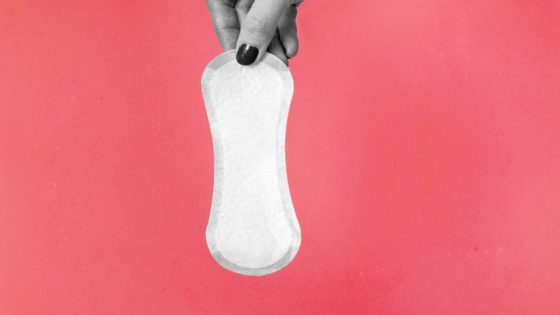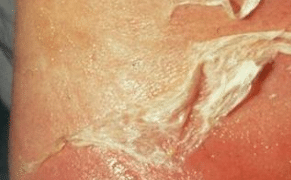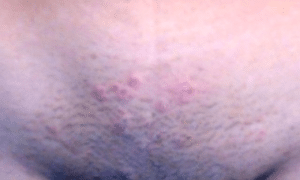White Spots
White Spots on Nails, Fingernails, Toenails, Marks, Dots, Causes, Vitamin Deficiency, How to Get Rid of, Pictures
on
What are the white spots on my nails? What causes white spots on nails? Get more insights on the causes of white marks on fingernails, toenails, treatment and home remedies for getting rid of patches, marks and dots on your nails.
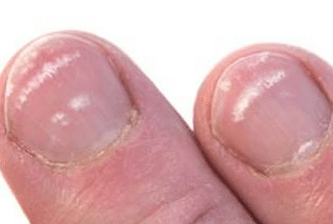
white spots on nails
White marks and spots are among then abnormalities on the nails that most people experience at one point in their lives. It is medically termed as leukonychia. The spots or marks are normally a sign of a fungal nail infection, injury or an indication of a serious underlying medical condition.
It is however important to visit your doctor if you notice a change in the color, texture, thickness and shape of your nails. There is always an appropriate treatment once your GP has identified the cause for your nail abnormalities.
What Causes White Spots on Nails
Here are some of the reasons for white marks on your nails:
1. Fungal Infection
Medical term for fungal nail infection is anychomycosis. Fungal infection develops slowly and causes nail to become discolored, distorted and thickened. According to studies, toenails are more frequently affected than fingernails.
Symptoms and Signs of a Fungal Nail Infection
- Fungal infection of the nail is characterized by the following:
- Discoloration of nails featured by white spots, black, yellow or green.
- Nail distortion and thickening in terms of shape and size.
- Pain and discomfort especially when a little pressure is applied on the affected nail.
- Crumby and brittle nails that breaks and become loose.
- Red, swollen and itchy skin around the affected nail.
How do you get a fungal nail infection?
Fungi naturally exist on the skin in a harmless manner. There are various factors that can make them to multiply and cause infections. They include the following:
- When you don’t keep your skin and feet clean and dry.
- Sweaty and hot feet caused by shoes.
- Walking barefoot in infectious places such as communal toilets and shower.
- Weak immune system.
- Underlying medical conditions such as diabetes, psoriasis, athlete’s foot or peripheral arterial disease.
Treatments for fungal nail infections
Most mild infections don’t necessarily need a serious treatment. Good foot and skin hygiene can help in curbing the infection to prevent spreading and re-infections. You can however seek medical intervention from a GP when you begin experiencing pain and discomfort.
Your doctor will however recommend the following treatments:
- Antifungal tablets that are taken once or twice daily.
- Antifungal nail paints that are applied directly on the nails.
- Nail softening kit that comprises of pate and scrapping device.
- Severe cases may attract complete removal of the nail.
- Laser treatment for nail fungus.
How to Prevent Fungal Nail Infections

white marks on nails
You can prevent this type of infection by use the following tips.
- Always keep your skin, hands and feet clean and dry.
- Wear a well-fitting shoes and socks especially those made with natural materials.
- Clip your nails short and avoid sharing of the used tools such as clippers or scissors.
- Do not share socks and towel with other people and also wash them frequently.
- Replace old footwear suspected to be contaminated.
- Treatment of the underlying medical conditions such as athlete’s foot immediately.
- Be careful with the manicure and nail salon tools used since they can also cause spreading.
2. Injury
Spots, dots or marks are a sign of a minor injury on the nail. Most of these spots show up some time later after the injury. This may however leave you with many questions as to why the white nail patches.
Some of the injuries include bending the nail, banging it while walking, incorrect clipping and manicure. Additionally, frequent contact of the nails with some materials like water, chalk dust can result to spots.
3. Allergic Reaction
White spots under nails can be due to allergic reactions to various substances and materials. Most common irritants include nail polish, nail hardener, polish remover, cleaning products such as detergents and chemical elements. Acrylic nails sometimes can cause trauma to the nail base hence causing white marks on fingernails.
4. Mineral and Vitamin Deficiency
There are a number of vitamin and mineral that can cause white spots on nails. They include the following:
Protein Deficiency.
Lack of sufficient amount of proteins in the body causes nail problems among other conditions. Horizontal and vertical ridges on nails, white dots, patches and marks are the main symptoms. A person may also feel moodiness and anxiety, body weakness, headache, confusion, troubled sleeping, poor healing of wounds, pale skin, nail brittle, weight loss and thinning hair.
Increase the protein intake for symptoms to disappear. Some of the foods you should use include: fish especially salmon or tuna, pork loin, turkey breast, nuts, lean beef, yogurt, beans, soy milk and tofu among others.
Zinc Deficiency.
White marks on nails is also a sign of lack of zinc in the body. Other symptoms include; growth and development complications, hair loss, mental slowness, loss of appetite, poor healing, weight loss, skin and eye conditions, impotence, change in taste and diarrhea.
You can increase the level of zinc in the body by consumption of zinc rich foods such as beef shanks, spinach, whole grains, yoghurt, pork shoulder, baked beans and nuts. Alternatively you can go for zinc supplements.
Calcium Deficiency.
White dots on both fingernails and toenails is a symptoms of calcium deficiency in the body. Other signs include numbness in the face, feet and hands, muscle spasms, insomnia and memory loss.
Calcium rich food can help in supply of this mineral iron in the body. Take foods such as milk, yoghurt, cheese, leafy greens, legumes and seafood.
Vitamin C Deficiency.
White spots under nails is also associated with lack of vitamin C in the body. This may accompany other symptoms such as easy bruising, unexplained bleeding, muscle and joint pains.
The following foods can help restore the levels of vitamin C in the body; orange juice, grapefruits, papayas, berries, bell peppers, citrus fruits, broccoli, dark leafy greens and tomatoes.
Iron deficiency
This is a type of anemia that can also cause nail problems. You can increase iron levels in the body by some foods such as red meat, pork, chicken meat, seafood, beans, green leafy vegetables, peas, spinach apricots and raisins.
5. Diseases and Conditions
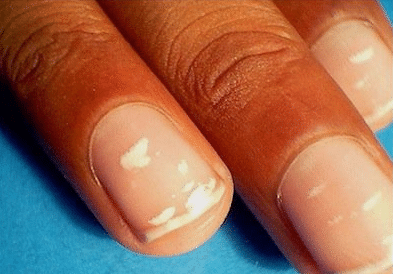
white spots on fingernails
Certain types of conditions are the reasons for white marks on nails. They include the following.
- Liver diseases such as cirrhosis and hepatitis.
- Kidney diseases such as failure.
- Anemia also causes white nails and pale nail beds.
- Koilonychias characterized by abnormally shaped, curved and thin nails.
White Spots on Nails Treatment
- Let the white on nails to grow out. When the marks grow past the nail bed, it is now the best time you can clip or file them. Do not cut too much since it can damage the nail bed. The entire process requires patience since it takes long.
- Keep your nails moisturized by use of suitable lotions or cream. This is highly recommended especially after washing dishes, cloth and after contact with dust such as chalk. Alternatively wear gloves to provide protection.
- Healthy diet is important for growth and development of healthy nails. Ensure your diet contains vitamins and mineral irons such as zinc, protein, calcium, vitamin C and iron along with other nutrients.
- Your nails should be properly cleaned and nicely cut. This helps in minimizing chances of infections. Manicures should be properly done and finished by application of a moisturizer. Use sharp scissors for trimming and carbon for filing.
- Always protect you nails from physical injuries. Be careful while gardening, washing and when walking.
- Visit a doctor if the while spots on nails are persistent and also if they associate other symptoms such as pain and discomfort. This will help to establish and treat any underlying medical condition.
How to Get Rid of White Spots on Nails Naturally – Home Remedies
White marks on nails caused by fungal infection can be treated naturally at home. The following are the best home remedies:
Coconut Oil
Coconut oil has strong antifungal properties suitable for tackling nail and toe fungus. It also form a barrier against moisture to the nail hence inhibiting multiplication of fungus. Apply on the affected nail, finger or toe three times a day.
Lemon Juice
Lemon is both antifungal and antibacterial agent that can help in treatment of related infections. Mix fresh lemon juice with little amount of iodine. Apply on the nails three times a day to get rid of fungal infection symptoms.
Garlic
This is a strong antifungal ingredient suitable for your infected nails. You can crush a fresh garlic clove and apply directly at the affected area or you can mix it with a base oil such as olive or coconut oil.
Yoghurt
Yoghurt contain Lactobacillus acidophilus suitable for the treatment of nail fungus. Apply on the nails and let it dry for 15 minutes before washing and drying thoroughly. Apply twice or thrice a day for effective outcome.
Lavender Oil
This is a suitable remedy for nail fungal infections due to its antifungal properties. Besides that, the oil also forms a protective later that helps in protecting the nails against moisture that forms a suitable media for fungus.
Tea tree Oil
Apply tea tree oil at the affected area to inhibit fungal activities. Tea tree oil possesses antifungal properties.
Vinegar
Soaking your nails in vinegar prevents both fungal and bacterial infections. Use twice or once daily for effective outcome.
Oregano oil
Apply oregano oil two times a day to cure fungal nail infections.
Thyme
This is an effective antioxidant suitable for the removal of white spots on nails. It is good at inhibiting fungal activities on the skin and nails. It also helps in keeping the body of free radicles that are responsible for most conditions.
Hydrogen Peroxide
This is an antifungal substance that can also help in relieve of patches, marks and dots on the nails caused by fungal infection. Place few drops on a cotton bud and apply on your nails twice or thrice a day.
White Marks on Nails
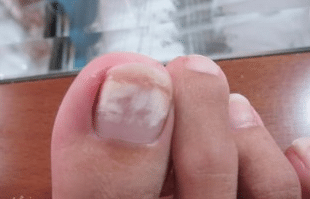
white spots on toenails
Different marks on the nails are medically classified depending on the causes as follows:
Leukonychia: This is also known as white nails or milk spots. This white discoloration of the nail is mostly caused by the above discussed factors. Most common one include injury to base of the nail, deficiency of calcium, zinc and vitamin C. There is no effective treatment but the marks go away on their own.
Leukonychia totalis: This is the whitening of the entire nail. It is a sign of various underlying conditions such as low albumin, kidney failure, liver failure and protein malabsorption. Certain derivatives of antibiotics are also the causes.
Leukonychia partialis: This is the whitening of the nail plate in the form of small white dots. It has three forms namely punctate, transverse and longitudinal. Severe form of this condition can lead to a more advanced one known as Leukonychia totalis.
Leukonychia striata: The condition is characterized by whitening of the nail in bands that run parallel the nail bse. It is mainly caused by physical nail injury or interruption of the nail matrix. Trauma from foot wear, lead poisoning, chemotherapy, extensive manicure are among the common causses.
Leukonychia punctate: These are white spots on nails caused by injury and trauma to the cells of the nails. Picking and biting especially among young children are the main reasons for this types of leukonychia.
Longitudinal leukonychia: This condition is characterized by formation of longitudinal white marks on nails which are visible under the nail plate. It is caused by an underlying condition known as Darier’s disease.
White Spots on Fingernails
Most people believe that white marks on the nails are due to calcium or zinc deficiency. According to studies, this is not always the case. These spots are sometimes harmless and doesn’t associate any mineral iron and vitamins at all.
For majority individuals, they are signs of a trauma that previously happened to the nail plate or the matrix which is the source of the nail plate located underneath the cuticle that is found under the skin.
Nail biting is behavioral and common as an expression of nervousness especially among children between 5 and 18. Other related habits include hair twisting, tooth grinding, nose and skin picking. It is a harmless habit although it associates health risks such as skin and nail infections.
Letting nails enough time in between manicures is recommended as a way of keeping them healthy. Besides drying out your nail, polish also risks fungal infections. Nails can speak about your body. Most doctors will examine your eyes, nails and mouth to establish your health status.
Stress and anxiety can also contribute to the white spots on nails. Besides associating nail picking and biting, it can also inhibit the growth of your nails. Chronic stress and body fatigue diverts important nutrients and energy away from your nails and hair.
More Sources and References:
- White Spots on Nails: http://www.newhealthguide.org/White-Spots-On-Nails.html
- White Marks on Nails: http://www.enkivillage.com/white-marks-on-nails.html
- Nail abnormalities: http://www.nhs.uk/conditions/nail-abnormalities/Pages/Introduction.aspx
- What are the white dots on my nails? http://health.howstuffworks.com/skin-care/nail-care/health/white-dots-on-nails.htm
- Fungal Nail Infection: http://www.healthline.com/health/fungal-nail-infection#Overview1
- Leukonychia: https://en.wikipedia.org/wiki/Leukonychia


